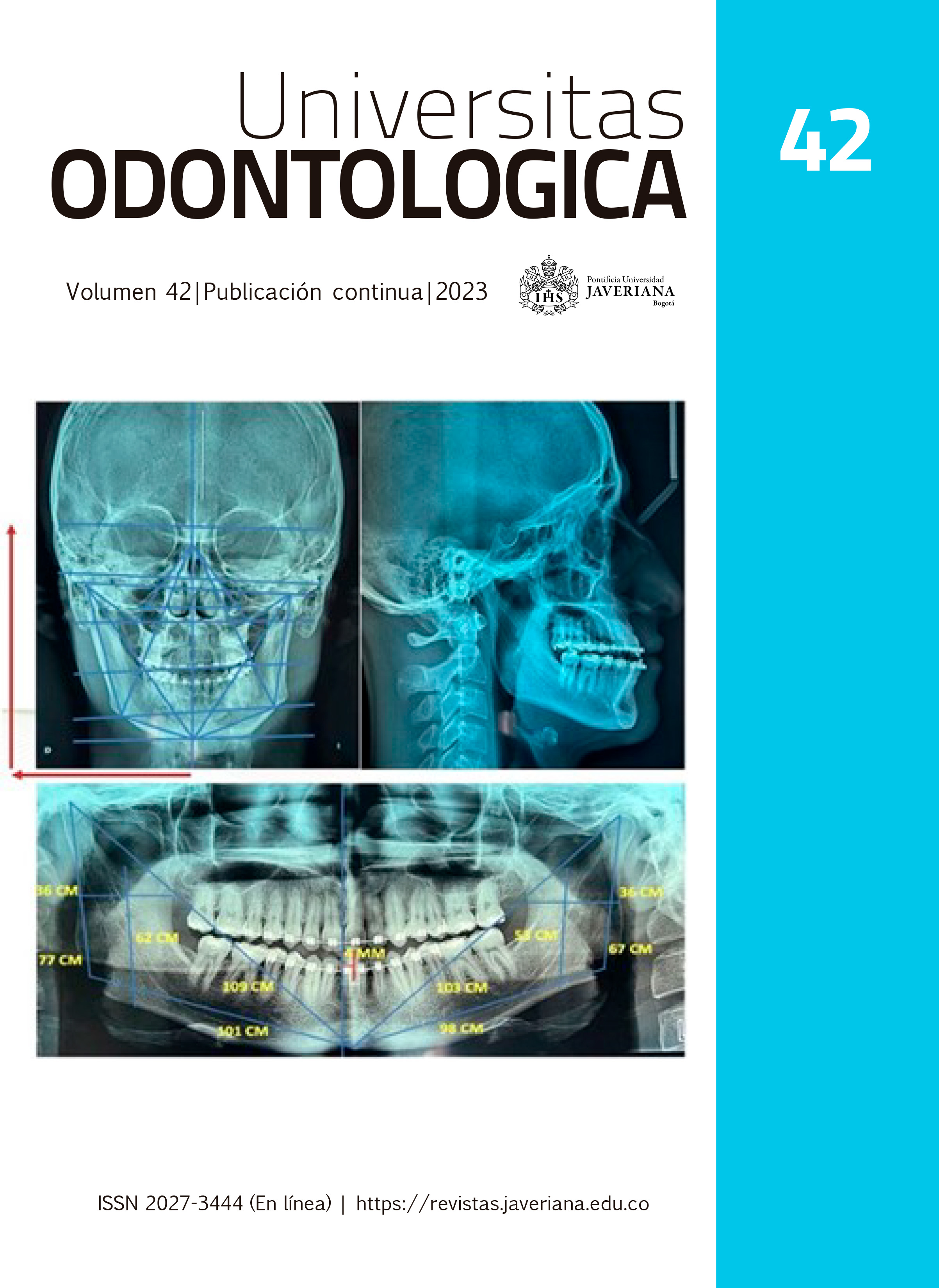Resumen
Introducción: El objetivo de esta revisión fue evaluar los cambios morfológicos mediante el uso de imagénes radiológicas de la articulación temporomandibular (ATM) tras la corrección de la maloclusión de clase II esquelética o dental con tratamiento funcional con aparatos en pacientes en crecimiento.
Materiales y métodos: Se realizó una revisión sistemática de la literatura a través de la búsqueda de literatura en diferentes bases de datos: PUBMED, EBSCO Embase y la BIBLIOTECA CHOCRANE, delimitando la búsqueda de 2015 a 2023. Esta búsqueda se realizó para conocer la literatura relacionada con la imagenología respecto a los cambios morfológicos de la ATM.
Resultados: Tras la revisión por parte de dos operadores se incluyeron un total de 17 artículos indexados.
Discusión y conclusiones: Los resultados indicaron que existen cambios morfológicos en la ATM después de la corrección de maloclusión clase II con aparatología funcional. El principal cambio descrito es el remodelado condilar, seguido de la adaptación morfológica de la fosa.
Cozza P, Baccetti T, Franchi L, De Toffol L, McNamara JA Jr. Mandibular changes produced by functional appliances in Class II malocclusion: a systematic review. Am J Orthod Dentofacial Orthop. 2006 May; 129(5): 599.e1-12; discussion e1-6. https://dx.doi.org/10.1016/j.ajodo.2005.11.010
Atresh A, Cevidanes LHS, Yatabe M, Muniz L, Nguyen T, Larson B, Manton DJ, Schneider PM. Three-dimensional treatment outcomes in Class II patients with different vertical facial patterns treated with the Herbst appliance. Am J Orthod Dentofacial Orthop. 2018 Aug; 154(2): 238-248.e1. https://dx.doi.org/10.1016/j.ajodo.2017.11.037
González FK, Lazo AY, LLanes RM. Syndrome type II division 2 malocclusions and temporomandibular dysfunction. Invest Medicoquir. 2020; 12(1): 1-18.
Kinzinger GSM, Lisson JA, Booth D, Hourfar J. Are morphologic and topographic alterations of the mandibular fossa after fixed functional treatment detectable on tomograms? Visual classification and morphometric analysis. J Orofac Orthop. 2018 Nov; 79(6): 427-439. English. https://dx.doi.org/10.1007/s00056-018-0156-y
Bhat Zeeshan I, Naik C, Rahalkar J. Early Intervention in Skeletal Class II and dental Class II division I malocclusion. APOS Trends in Orthodontics.2013; 3: 121. https://dx.doi.org/10.4103/2321-1407.117380
Nishanth B, Gopinath A, Ahmed S, Patil N, Srinivas K, Chaitanya ASK. Cephalometric and computed tomography evaluation of dentoalveolar/soft-tissue change and alteration in condyle-glenoid fossa relationship using the PowerScope: A new fixed functional appliance for Class II correction –A clinical study. Int J Orthod Rehabil. 2017; 8(2): 41. https://dx.doi.org/10.4103/ijor.ijor_5_17
Kyburz KS, Eliades T, Papageorgiou SN. What effect does functional appliance treatment have on the temporomandibular joint? A systematic review with meta-analysis. Prog Orthod. 2019 Aug 12; 20(1): 32. https://dx.doi.org/10.1186/s40510-019-0286-9
Watted N, Witt E, Kenn W. The temporomandibular joint and the disc-condyle relationship after functional orthopaedic treatment: a magnetic resonance imaging study. Eur J Orthod. 2001 Dec; 23(6): 683-693. https://dx.doi.org/10.1093/ejo/23.6.683
Souki BQ, Vilefort PLC, Oliveira DD, Andrade I Jr, Ruellas AC, Yatabe MS, Nguyen T, Franchi L, McNamara JA Jr, Cevidanes LHS. Three-dimensional skeletal mandibular changes associated with Herbst appliance treatment. Orthod Craniofac Res. 2017 May; 20(2): 111-118. https://dx.doi.org/10.1111/ocr.12154
Elfeky HY, Fayed MS, Alhammadi MS, Soliman SAZ, El Boghdadi DM. Three-dimensional skeletal, dentoalveolar and temporomandibular joint changes produced by Twin Block functional appliance. J Orofac Orthop. 2018 Jul;79(4): 245-258. English. https://dx.doi.org/10.1007/s00056-018-0137-1
Gandedkar NH, Shrikantaiah S, Patil AK, Baseer MA, Chng CK, Ganeshkar SV, Kambalyal P. Influence of conventional and skeletal anchorage system supported fixed functional appliance on maxillo-mandibular complex and temporomandibular joint: A preliminary comparative cone beam computed tomography study. Int Orthod. 2019 Jun; 17(2): 256-268. https://dx.doi.org/10.1016/j.ortho.2019.03.008
Jiang YY, Sun L, Wang H, Zhao CY, Zhang WB. Three-dimensional cone beam computed tomography analysis of temporomandibular joint response to the Twin-block functional appliance. Korean J Orthod. 2020 Mar;50(2):86-97. https://dx.doi.org/10.4041/kjod.2020.50.2.86
Wei RY, Atresh A, Ruellas A, Cevidanes LHS, Nguyen T, Larson BE, Mangum JE, Manton DJ, Schneider PM. Three-dimensional condylar changes from Herbst appliance and multibracket treatment: A comparison with matched Class II elastics. Am J Orthod Dentofacial Orthop. 2020 Oct; 158(4): 505-517.e6. https://dx.doi.org/10.1016/j.ajodo.2019.09.011
Fan Y, Schneider P, Matthews H, Roberts WE, Xu T, Wei R, Claes P, Clement J, Kilpatrick N, Penington A. 3D assessment of mandibular skeletal effects produced by the Herbst appliance. BMC Oral Health. 2020 Apr 16; 20(1): 117. https://dx.doi.org/10.1186/s12903-020-01108-4
Nindra J, Sidhu MS, Kochhar AS, Dabas A, Valletta R, Rongo R, Spagnuolo G. Three-Dimensional Evaluation of Condyle-Glenoid Fossa Complex Following Treatment with Herbst Appliance. J Clin Med. 2021 Oct 15; 10(20): 4730. https://dx.doi.org/10.3390/jcm10204730
Parvathy RM, Shetty S, Katheesa P. Evaluation of changes seen in TMJ after mandibular advancement in treatment of Class II malocclusions, with functional appliances, a CBCT study. Biomed (Trivandrum). 2021; 41(2): 236-242. https://doi.org/10.51248/.v41i2.789
Shetty V, Shetty K. Evaluation of skeletal changes in mandibular ramus height, corpus length, and mandibular angle changes following twin block appliance therapy using cone-beam computed tomography: A clinical prospective study. Int J Orthod Rehabil. 2021; 12(3): 115. https://doi.org/10.4103/ijor.ijor_3_21

Esta obra está bajo una licencia internacional Creative Commons Atribución 4.0.
Derechos de autor 2023 Jordi Tomàs Aliberas, Catalina Pizarro Lavin, Dídac Sotorra Figuerola, Natalia Felipe Spada


